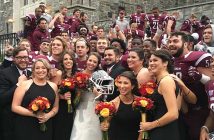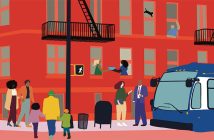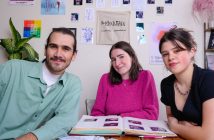When I lived in Dublin and met an Irish person, I would almost always get the same two questions. The first one was often asked with a raised brow: “Do you know that Colleen means ‘girl’ in Irish?” I quickly tired of that question. But the second one I never tired of hearing because it was always asked with respect and excitement: “You used to live in the Bronx?!”
I bring this up not only to thank Fordham for the street cred it earned me among my Irish friends but also because it shows that when I moved to Ireland, I talked about Fordham and the Bronx quite a lot, to strangers and friends alike.
The link between Ireland and the States is self-evident: It’s there in history, in street names and surnames, in Irish-American culture, in St. Patrick’s Day, which we celebrate by marching up Fifth Avenue.
But the link that joins Fordham, New York, and Ireland is not so generic as to be reduced to the common knowledge of mass Irish immigration to America in the mid-19th century. It’s a link that is constantly revitalized. My life, from the moment I stepped foot in the Bronx at the age of 18 seven years ago, has been living proof of that fact.
I grew up in Connecticut as an obsessive Irish dancer, going to feiseanna every weekend, dancing at local halls and television studios, even skipping school on St. Patrick’s Day. Like many other Irish Americans, I grew up listening to tales about the home country, the stories my aunts and uncles would tell about the family farm in County Clare. Since I was a small child, I loved Ireland, but it wasn’t until I came to Fordham that I truly learned what it means to be Irish. At Fordham, I came to know Ireland outside of its myth.
Getting in Tune
One of the best things to ever happen to me occurred during my freshman year at Fordham, when I became involved with WFUV’s Irish music program, Ceol na nGael, the Music of the Irish. I was blessed to carry the torch of hosting the show, and every Sunday afternoon my co-host and I sat before the mics in the studio in Keating Hall.
The tunes we played were our weekly bridge to the greater New York Irish network, to our listeners across the nation and even across the Atlantic to our Irish fan base. Each Sunday we’d get a slew of requests for the community’s favorite Irish classics—folk songs like “The Fields of Athenry,” “When New York Was Irish,” and “The Leaving of Liverpool.” After only a few months at FUV, I had the lyrics to all those ballads memorized, and I used to sing them in my awful soprano to my roommates when I’d head back to my dorm on a Sunday night.
But the music wasn’t only with me on Sundays. Those ballads merged with my weekday life as a student. During my sophomore year, I took a course in Irish-American history as part of my Irish studies minor. One particular class meeting we focused our discussion on Famine history, and I remember how the whole class took a moment to pause our conversation and reflect in silence at the staggering reality of the recorded numbers: 1 million dead, over 1 million immigrants, all in just five years. We sat together in disbelief as we realized even today Ireland hadn’t recovered its population.
As I left class that day, I popped my headphones in to prepare for my walk across campus. “The Fields of Athenry” happened to come on my shuffle as I walked, and with the class discussion still whirling in my mind, I listened to the lyrics of that ballad, really listened to them for the first time. I bore witness to the song’s story of Michael, who stole food to feed his family and was forced to depart on a prison ship—a narrative that, I knew from my class, was based in historical truth.
The gorgeous melody played out as I walked past Keating Hall, making my way toward the McGinley Center to meet my friends for lunch, and I thought about all the immigrant laments I played for our listeners on Sunday. I realized I had never really, truly considered the impact of those words, nor the melancholic notes that backed them. For the first time, I stepped outside my family’s glorified ancestral account and I thought about what it really would have felt like for my great-grandfather to arrive in New York City with less than 10 dollars in his pocket, to stare up at the high-rise buildings, when the biggest he’d known previously was a two-story tavern at the crossroads of his small village in County Clare. I thought about what it would have felt like for him knowing he would likely never again hear from his sister, who had gone to Australia, what it would have felt like for him to be on his own at the incredibly young age of 14.These reflections didn’t shatter the illusion of my family’s folktales. Rather, I felt more connected to my family history than I ever had been before. The next Sunday, as I prepared for Ceol na nGael, I included “The Fields of Athenry” on my playlist, and I chose one for my great-grandfather too: “From Clare to Here.”
Finding an Irish Voice
Such an anecdote was characteristic of my Fordham education—what I learned in the classroom always pushed beyond the facts to the feeling and ethics behind the knowledge. At Fordham, I gained more than history, however. I gained, or rather, regained, a language. I can’t think of many other colleges that would have provided me the opportunity to learn a minority language like Irish; and Fordham even did more than that—the college sponsored me to travel to Connemara for a summer and live in the Gaeltacht, to break bread every day with an Irish-speaking family and enhance my conversational skills. By the time I was a junior at Fordham, I had an entirely different voice than when I first arrived in the Bronx. For the most part I sounded the same—my accent hadn’t changed, much to my dismay. But in just two years’ time I was able to slip into a language that hadn’t been spoken in my family for generations.
Fordham not only made me a better speaker of English and Irish, it made me a better listener as well. When home for Thanksgiving the first autumn after my summer in Connemara, I overheard my mother and my uncle talking in the kitchen while preparing the turkey. When my mom laughingly told my uncle, in her thick pseudo-New York accent, to “put the kaibosh on all that baloney he was chatting,” she was, unbeknownst to herself, speaking a form of Irish.
Kaibosh comes from the Irish caidhp and bás—caidhp in Irish is a hat, and bás means death, so kaibosh becomes a “death cap.” Put the kaibosh on it. Put an end to it, already. As for baloney, you might be surprised to hear that slang word isn’t related to the deli meat, but to the Irish béal ónna, which means “silly mouth” or “silly talk.” Later that night at Thanksgiving dinner, when my brother asked my cousin if there was any gravy left, and she replied, “There’s gravy galore,” I heard Irish again. Galore comes from the Irish go leor, which sounds and means, like it does for our Irish-American slang, “plenty” or “a lot.”
The myth that Irish was a dead language, the myth that my family was strictly monolingual, was irreversibly broken that Thanksgiving. I heard in old family phrases the new Irish words I had learned in Connemara; I heard how a centuries’ old language breathed new life each day in contemporary American conversation.
Through history, song, and language, my roots back to my ancestral past in Ireland grew stronger and stronger with each month of my time at Fordham. But perhaps the most important tie Fordham sewed for me was through literature and surprisingly through feminism.
Songs of the Unsung
My challenging liberal arts education as an English major at Fordham made me thirsty for further study. With support from my faculty mentors at Fordham, I was accepted at my dream program, the Master’s in Irish Writing at Trinity College Dublin. For a year I read the great Irish works of Joyce and Beckett, Swift and Yeats. I walked down Nassau and Grafton Streets every day, took a turn around Stephen’s Green regularly, passed by the home of the Book of Kells on my walk to class, learned, wrote, and virtually lived (as it felt in those arduous essay-writing months) in the house where Oscar Wilde was born on Westland Row, where our master’s course met for study.
By the time the final leg of the dissertation came along, I was surprised but thrilled to find myself in the college’s rare and early printed books room, reading an original copy of a novel published in 1809 by a young a woman from Dublin—a novel only I and a handful of other Irish scholars today have read. I gladly took the risk of making an argument for this unknown writer named Sarah Isdell and her little-known novel, The Irish Recluse, a rather radical narrative about a woman who creates a feminocentric family unit in a castle in Kerry.
At the end of the work I conducted for my master’s, I looked down at my 70-page dissertation—at the work I had slaved over, that I was so proud of, that had cost my poor father a tearful international call or two from his daughter—and it suddenly registered that my connection with this novel had roots in a speech I heard on freshman orientation day at Fordham.
“To be bothered.” That’s what Joseph M. McShane, SJ, president of Fordham, said he wanted out of us as students: to leave Fordham bothered by the questions our education had raised, by what we encountered outside the University walls.
I was undoubtedly romanced by the literature I had studied at Trinity, by Dublin’s historical charms, but I never let that romance eclipse the Jesuit ideal of justice and suspicion that had been ingrained in my undergraduate education. Whether I was conscious of it at the time or not, I was quietly bothered by that androcentric syllabus list I received on my first day at Trinity, by academia’s small, sometimes exclusionary canon of authors. I left Trinity more widely read, more worldly and confident than when I had arrived, but I left it the way I left Fordham, the way Father McShane encouraged us to feel—bothered. I knew I had more work to do for Irish feminist literary criticism, and it was that inquiry that brought me to Boston in pursuit of a PhD.
Making the Irish American
I share all these personal anecdotes not to wax lyrical about myself, but to demonstrate that Irishness is a multifaceted, complex, precious, and constantly unfolding thing. Irish culture comes from a place of struggle and pain, but beauty as well, laughter and spirit, all expressed in the most exquisite art forms, and yes, even in a bit of myth and magic. If I hadn’t gone to Fordham, I’d only know the mere surface of this cultural depth.
Now that I live in the States again, I often get asked—with a similar expression of respect—“You used to live in Dublin?” And when I go back to Ireland this summer, I’m sure I’ll get that same interest in my Bronx connections when I swap international stories with the people I encounter.
In the Irish language, when someone asks you where you’re from, the reply is phrased Is as mé, which directly translates as “I am of.” I am of New York and of the Bronx, and I am of Dublin just as much as I am of a tiny town in Connecticut, and maybe even still of a tiny town in County Clare.
To be Irish American is to be of many places and to be of two nations, to inhabit two homes at once. I am grateful to Fordham for teaching me how invaluable that multiplicity is.
One of the most common signatures of being Irish is a reverence for folklore. No doubt the Irish have an instinctive penchant for telling stories. Walk into any pub in any town in Ireland, and you’ll see it proven true.
But I think the best part of Irish culture are the stories that haven’t been told, the ones muffled by history and prejudice.
So I encourage you to listen thoughtfully to the Irish tales you hear in conversation. Listen thoughtfully to the lyrics of a Dubliners ballad or the words of a Seamus Heaney poem. Go to Ellis Island and listen to its silence. Hear again, with new ears, the very sound of your own name. There are more stories lingering there than you realize, more stories waiting to be recorded. Irish America is a story only partially written, and it’s places like Fordham that inspire us to fill the empty pages.



